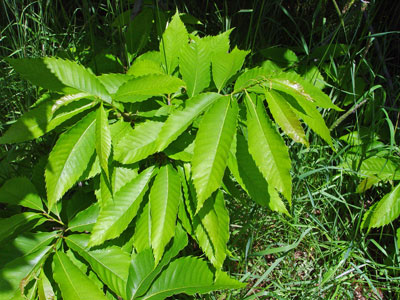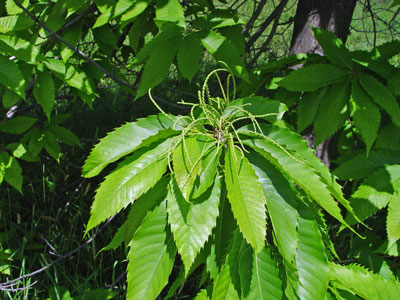DACF Home → Bureaus & Programs → Maine Natural Areas Program → Communities, Plants, and Animals → Rare Plants → Castanea dentata

Castanea dentata (Marsh.) Borkh
American Chestnut
- State Rank: S4
- Global Rank: G3
- State Status: Special Concern
Habitat: Dry gravelly or rocky, mostly acidic soil. [Hardwood to mixed forest (forest, upland)]
Range: Georgia to Mississippi, north to southern Maine and southern Ontario.
Aids to Identification: Castanea dentata is a forest tree with large, coarse-toothed leaves. In the past, specimens grew to 30 m in height, but now most are smaller, about 8 m. The edible nuts are enclosed in a spiny husk; several nuts per husk. Chestnut is distinguished from the similar beech (Fagus grandifolia) by its longer leaves and petioles and its blunt buds. Though often confused in conversation, it is not closely related to the horse-chestnut (Aesculus hippocastanum), a widely planted non-native ornamental tree that has palmately compound, opposite leaves and showy white flowers.

Ecological characteristics: Formerly a dominant species of central hardwood forests, but now limited to small specimens and sprouts from old stumps. It still occurs in all New England states but the trees often are killed by a fungus before they reach a large size.
Phenology: Flowers June - August, and nuts ripen September - October.
Family: Fagaceae
Synonyms: Fagus-castanea dentata Marsh.
Known Distribution in Maine: This rare plant has been documented from a total of 7 town(s) in the following county(ies): Cumberland, Knox, Piscataquis, Somerset, York.
Reason(s) for rarity: Most of the population was decimated by a fungus (Chestnut blight) in the early 1900's. The tree rarely attains mature size.
Conservation considerations: Most trees succumb to blight before they reach fruiting size. Those that do reach maturity may have blight resistance, an important feature to conserve. Because chestnuts typically occur as one or a few trees, working around viable individuals is often feasible. Tracked populations in Maine consist of mature trees in excellent natural settings. These trees are mature and produce viable fruit. Stump spouts (which are common in the southern portion of the state) are not included in MNAPs database, as these typically do not flower and produce fruit.